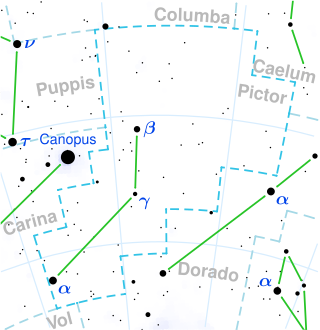Related Research Articles

Gamma Sculptoris, Latinized from γ Sculptoris, is a single, orange-hued star in the constellation Sculptor. Based upon an annual parallax shift of 17.90 mas as seen from Earth, this star is located about 182 light years from the Sun. It is bright enough to be visible to the naked eye with an apparent visual magnitude of 4.41. It is moving away from the Sun with a radial velocity of +15.6 km/s.

Tau Tauri, Latinized from τ Tauri, is a quadruple star system in the constellation Taurus. It is visible to the naked eye as a faint point of light with a combined apparent visual magnitude of 4.33. The distance to this system is approximately about 400 light years based on parallax. The system is moving further from the Earth with a heliocentric radial velocity of +14.6 km/s, and it is a member of the Taurion OB association, located between Orion and Taurus. It is located 0.7 degree north of the ecliptic, and thus is subject to lunar occultations.

Sigma Persei is an orange K-type giant with an apparent magnitude of +4.36. It is approximately 360 light years from Earth.

Upsilon Ophiuchi is a triple star system in the equatorial constellation of Ophiuchus. It has a white hue and is faintly visible to the naked eye with an apparent visual magnitude of 4.62. The distance to this system is approximately 134 light years based on parallax. It is drifting closer with a radial velocity of −30.6 km/s.

72 Pegasi is a binary star system in the northern constellation of Pegasus. It is visible to the naked eye as a faint, orange-hued point of light with a combined apparent visual magnitude of 4.97. The system is located approximately 550 light years away from the Sun, based on parallax, but is drifting closer with a radial velocity of −25 km/s.

HD 18970 is a class G9.5III star in the constellation Perseus. Its apparent magnitude is 4.77 and it is approximately 211 light years away based on parallax.

HD 20468 is a class K2II star in the constellation Perseus. Its apparent magnitude is 4.82 and it is approximately 1180 light years away based on parallax.

HD 63922 is a class B0III star in the constellation Puppis. Its apparent magnitude is 4.11 and it is approximately 1600 light years away based on parallax.

HD 69142 is a class K1II-III star in the constellation Puppis. Its apparent magnitude is 4.44 and it is approximately 298 light years away based on parallax.

HD 61330 is a class B8IV star in the constellation Puppis. Its apparent magnitude is 4.53 and it is approximately 360 light years away based on parallax.

HD 65810 is a class A2V star in the constellation Puppis. Its apparent magnitude is 4.61 and it is approximately 241 light years away based on parallax.

NV Puppis, also known as υ1 Puppis, is a class B2V star in the constellation Puppis. Its apparent magnitude is 4.67 and it is approximately 800 light years away based on parallax.

HD 63744 is a class K0III star in the constellation Puppis. Its apparent magnitude is 4.71 and it is approximately 232 light years away based on parallax.

HD 70555 is a class K2.5II-III star in the constellation Puppis. Its apparent magnitude is 4.83 and it is approximately 1,010 light years away based on parallax.

HD 61831 is a class B2.5V star in the constellation Puppis. Its apparent magnitude is 4.84 and it is approximately 556 light years away based on parallax.

HD 53811 is a class A4IV star in the constellation Puppis. Its apparent magnitude is 4.92 and it is approximately 198 light years away based on parallax.

HD 50235 is a class K5III star located approximately 811 light years away, in the constellation Puppis. Its apparent magnitude is 4.99. HD 50235 made its closest approach to the Sun 7.8 million years ago, at the distance of 137 light years, during which it had an apparent magnitude of 1.13.

HD 167818 is a class K3II star in the constellation Sagittarius. Its apparent magnitude is 4.66 and it is approximately 760 light years away based on parallax.
HD 190056 is a class K1III star in the constellation Sagittarius. Its apparent magnitude is 4.99 and it is approximately 291 light years away based on parallax.

HD 42540, also known as HR 2196, is a giant star in the constellation Pictor. A class K2-3III orange giant, its apparent magnitude is 5.04 and it is approximately 389 light years away based on parallax.
References
- 1 2 3 4 5 6 Van Leeuwen, F. (2007). "Validation of the new Hipparcos reduction". Astronomy and Astrophysics. 474 (2): 653–664. arXiv: 0708.1752 . Bibcode:2007A&A...474..653V. doi:10.1051/0004-6361:20078357. S2CID 18759600. Vizier catalog entry
- 1 2 3 4 Anderson, E.; Francis, Ch. (2012). "XHIP: An extended hipparcos compilation". Astronomy Letters. 38 (5): 331. arXiv: 1108.4971 . Bibcode:2012AstL...38..331A. doi:10.1134/S1063773712050015. S2CID 119257644. Vizier catalog entry
- 1 2 Hoffleit, D.; Warren, W. H. (1995). "VizieR Online Data Catalog: Bright Star Catalogue, 5th Revised Ed. (Hoffleit+, 1991)". VizieR On-line Data Catalog: V/50. Originally Published in: 1964BS....C......0H. 5050. Bibcode:1995yCat.5050....0H.
- 1 2 Mallama, A. (2014). "Sloan Magnitudes for the Brightest Stars". The Journal of the American Association of Variable Star Observers. 42 (2): 443. Bibcode:2014JAVSO..42..443M. Vizier catalog entry
- ↑ Wilson, R. E. (1953). "General Catalogue of Stellar Radial Velocities". Carnegie Institute Washington D.C. Publication. Carnegie Institution for Science. Bibcode:1953GCRV..C......0W. LCCN 54001336.
- ↑ Soubiran, Caroline; Le Campion, Jean-François; Brouillet, Nathalie; Chemin, Laurent (2016). "The PASTEL catalogue: 2016 version". Astronomy & Astrophysics. 591: A118. arXiv: 1605.07384 . Bibcode:2016A&A...591A.118S. doi:10.1051/0004-6361/201628497. S2CID 119258214.
- ↑ De Medeiros, J. R.; Alves, S.; Udry, S.; Andersen, J.; Nordström, B.; Mayor, M. (2014). "A catalog of rotational and radial velocities for evolved stars". Astronomy & Astrophysics. 561: A126. arXiv: 1312.3474 . Bibcode:2014A&A...561A.126D. doi:10.1051/0004-6361/201220762. S2CID 54046583. Vizier catalog entry